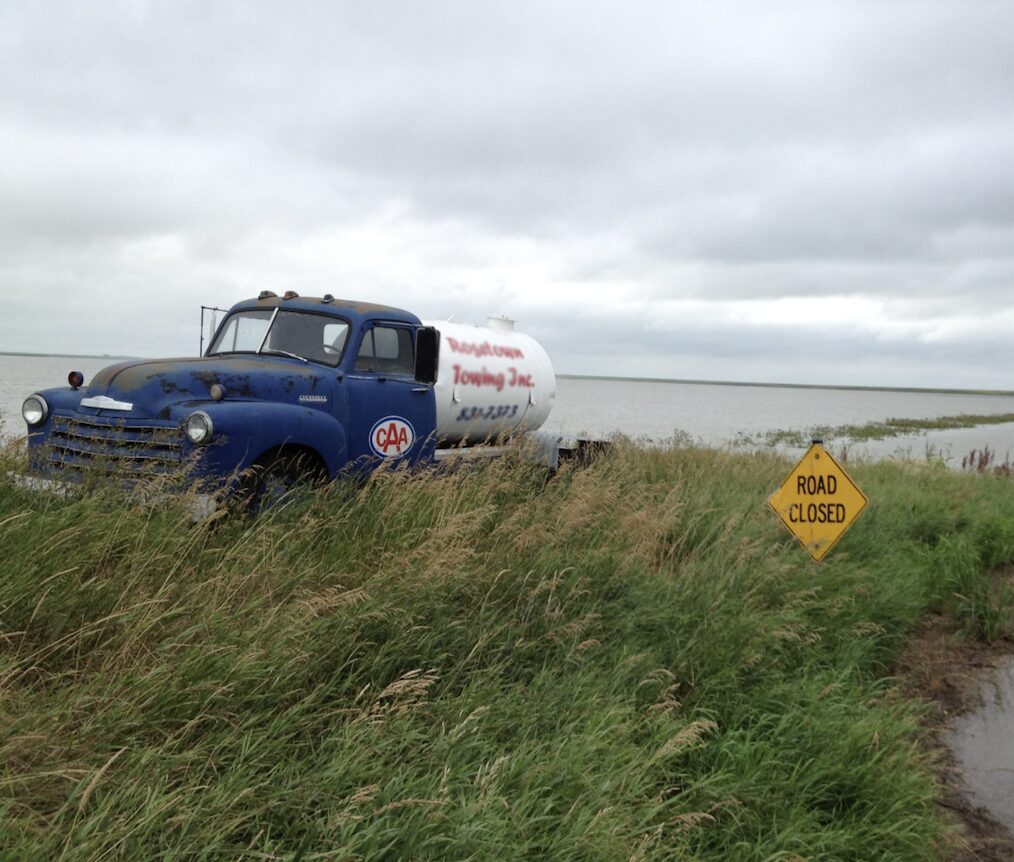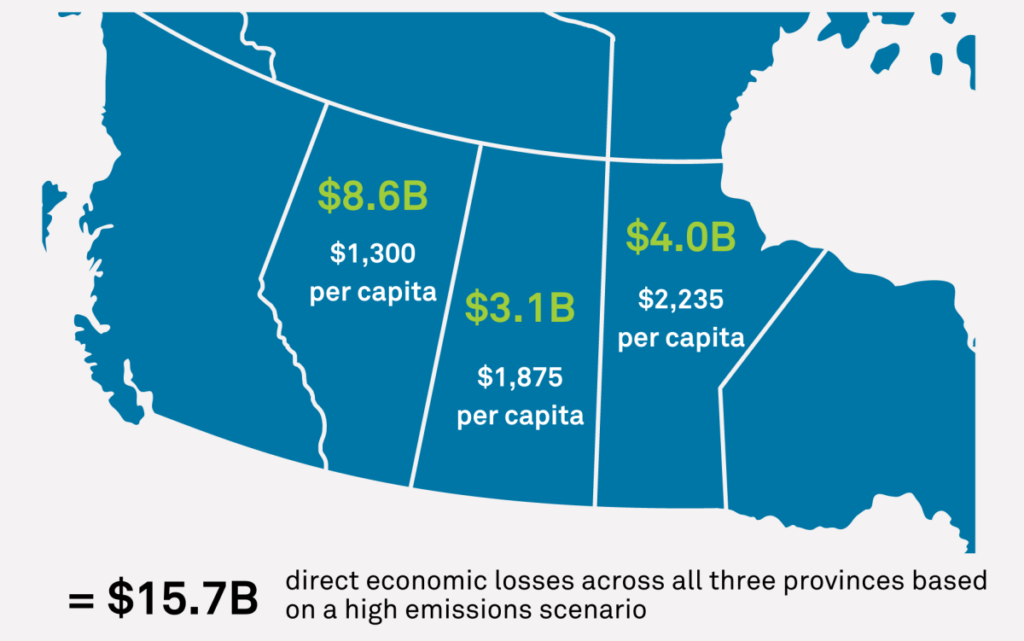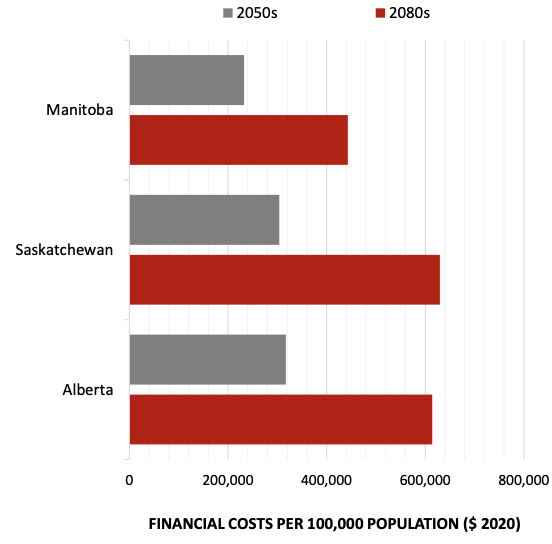What are the financial costs of climate change in the Prairie Provinces?

Introduction
Decision-makers face significant challenges when it comes to responding to a changing climate. There are many different considerations depending on the size, geography and unique characteristics of each community or organization. Regardless of the differences, all decision-makers should ask themselves the same question: what might it cost if we do nothing?
Understanding the economic consequences of climate change is crucial in determining when and how much to invest in adaptation. This information is particularly important in the Prairie provinces which are a hotspot for climate change – not just within Canada, but across the world (Loxley, 2022). Findings from a 2020-21 regional survey identified that Prairies region communities want more data on the impacts of climate change and how local business, infrastructure, and human health are affected.
ClimateWest commissioned All One Sky to review various existing studies that investigate the costs of climate change on the Prairies and in Canada. The Costs of Climate Change on the Prairies report synthesizes this literature into a single compendium of the costs of inaction for the Prairies reflecting the current state-of-knowledge.
This article is an abridged version of the original text, which can be downloaded from the right-hand column. Please access the original text for more detail, research purposes, full references, or to quote text.
Key Findings
Overall the report highlights that while our changing climate is anticipated to bring some benefits for the Prairies, the total economic impact is projected to be overwhelmingly negative and significant.
Losses by Province
The report examines insured losses by province from extreme weather up to 2021. While the combined losses across Alberta, Saskatchewan, and Manitoba are conservatively estimated at almost $16 Billion per year by the 2050s under a high emissions scenario, over half of these losses are in Alberta because of its larger population, asset inventory and economy. On an annual per capita basis, the largest losses are expected to occur in Manitoba ($2,235 per person), followed by Saskatchewan ($1,875 per person), then Alberta ($1,300 per person).

Key findings across climate-sensitive sectors analysed in the report based on a high emissions scenario include:
Public Health
Climate change is already adversely affecting the health of Canadians, with the consequences projected to worsen with further climate change. Three public health hazards anticipated to worsen with further climate change in the Prairies include: exposures to ground-level ozone, high temperatures, and Lyme disease.
The numbers: Losses of $11.5 billion (2050s) to $28.9 billion (2080s) annually from public health impacts.

Worker Productivity
Notwithstanding the significance of the health risks for the general public, climate change may present an even greater risk to the health and safety of the workforce. Employees are often exposed to the effects of climate change for longer durations and at greater intensities than the public.
The numbers: Losses of $0.7 billion (2050s) to $1.8 billion (2080s) annually from reduced worker productivity due to higher temperatures.
Transportation Infrastructure
Transportation systems consist of a vast, interconnected network of assets and derived services, that serve as the backbone of economic and social activity across the Prairies. But a changing climate undermines the system’s ability to perform reliably, safely, and efficiently.
The numbers: Losses of $1.6 billion (2050s) to $3.8 billion (2080s) annually from damages to transportation infrastructure and associated delays in the movement of people and freight.
Electricity Infrastructure
Electricity transmission and distribution infrastructure will likely be adversely affected by several climate impact-drivers, including: (a) increased temperatures, which increase line losses and reduce carrying capacity; (b) extreme precipitation events that increase the risk of flooding of ground level and underground assets; and (c) high winds, freezing rain, wildfires and heavy snow events that can damage poles and towers and down lines.
The numbers: Losses of $0.6 billion (2050s) to $1.1 billion (2080s) annually from damages to electricity transmission and distribution infrastructure and changes in electricity demand to heat and cool buildings.
Buildings
In addition to infrastructure, buildings are another key component of the built environment where the economic impacts of climate change have been assessed in the Prairies.
The numbers: Losses of $1.2 billion (2050s) to $1.8 billion (2080s) annually from damages to building structures and contents resulting from river and stormwater flooding.
Agriculture
Moderate levels of warming and increased carbon dioxide in the atmosphere could help some plants to grow faster or allow some farmers to shift to crops that are currently grown in warmer areas. However, more severe warming, and changes in the frequency and intensity of droughts and floods could pose challenges for farmers, reducing yields.
The numbers: Increases in farmland values of $3.4 billion (2050s) to $4.3 billion (2080s) annually from rising productivity due to seasonal warming, a longer growing season and increases in total annual precipitation.
Note, the report indicates these estimates as optimistic as they do not account for some other significant challenges that climate change presents such as heat stress and impacts to water availability, as well as increased risks of pests, vector-borne diseases and invasive species.
Forestry
Many climate impact-drivers are likely to—directly or indirectly—affect the forestry industry on the Prairies. Climate change is anticipated to alter the frequency and intensity of forest disturbances, such as wildfires, storms, insect outbreaks, and the prevalence of invasive species. Increases in temperature, changes in precipitation, and increases in carbon dioxide are likely to impact the growth and productivity, as well as the distribution of forests.
The numbers: Loss of $3.4 billion annually in projected Gross Domestic Product (GDP) for Prairie provinces, the Yukon and Northwest Territories over the period 2010-2080 from reduced timber supply.
Conclusion
The report concludes by stating the projected economic risks of climate change for the Prairies may be larger than the estimates presented in this report, due to a number of knowledge gaps. However, this information can still be used to inform the overall scale of investment in adaptation, and the selection, timing and sequencing of specific adaptation options, as well as the distribution of adaptation costs and benefits.
Many of the report findings were presented by the author, Dr. Richard Boyd at the inaugural ClimateWest Forum, held in May 2023 in Winnipeg, Manitoba. Two of the key takeaways from the Forum were that proactive climate adaptation action offers a good return on investment, and that there is a need to scale up adaptation investments to match the risks that Canadians face. Per year, one study estimated that 0.26% of GDP is needed nationally to be invested in municipal climate adaptation investments (IBC & FCM, 2020).
As decision-makers increasingly want more information on the economic consequences of climate change, the report supports a strong business case for proactive climate adaptation in the Prairies provinces and beyond.
Further Resources
Article citation:
Boyd, R., 2023. Costs of Climate Change on the Prairies. Prepared by All One Sky Foundation for ClimateWest.
(0) Comments
There is no content